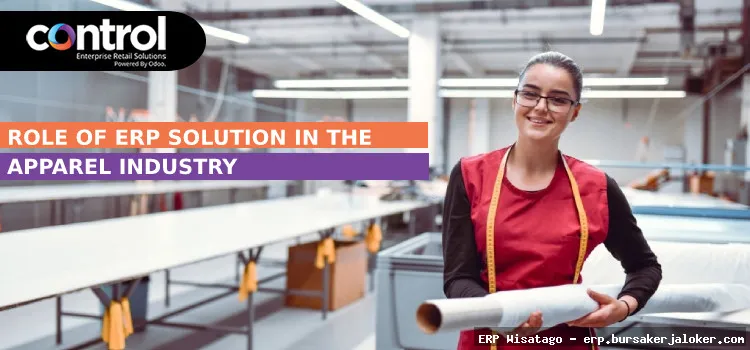The apparel industry, with its intricate supply chains, ever-changing trends, and demanding customers, faces unique operational challenges. From design and sourcing to manufacturing, distribution, and retail, every stage requires meticulous planning and execution. In today’s competitive landscape, relying on outdated systems or manual processes simply isn’t sustainable. This is where Enterprise Resource Planning (ERP) systems come into play, offering a powerful solution to streamline operations, improve efficiency, and ultimately, drive profitability.
Implementing an ERP system is a significant undertaking, often perceived as a complex and daunting task. I’ve been involved in several ERP implementations, and I understand the anxieties businesses face: Will it be worth the investment? Will it disrupt our operations? Will our employees adapt? The truth is, a well-chosen and properly implemented ERP system can be transformative, but it requires careful planning, a clear understanding of your business needs, and a commitment to change management.

This guide aims to provide a comprehensive overview of ERP systems specifically tailored for the apparel industry. We’ll delve into the key features, benefits, and considerations involved in selecting and implementing an ERP solution. Whether you’re just starting to explore ERP options or looking to optimize your existing system, this article will equip you with the knowledge you need to make informed decisions and navigate the ERP journey successfully. We’ll also discuss common pitfalls and lessons learned from real-world implementations, helping you avoid costly mistakes and maximize your return on investment.
What is ERP and Why is it Important for the Apparel Industry?
ERP, or Enterprise Resource Planning, is a software system that integrates all facets of a business, including planning, manufacturing, sales, marketing, finance, human resources, and more. It provides a centralized platform for managing data and processes, enabling real-time visibility and improved decision-making across the entire organization. In the apparel industry, this integration is particularly crucial due to the complex and interconnected nature of its operations.
Key Challenges in the Apparel Industry
The apparel industry faces a unique set of challenges that make ERP a necessity:
- Complex Supply Chains: Sourcing raw materials, managing multiple suppliers, and coordinating production across different locations can be incredibly complex.
- Fast Fashion and Seasonality: The need to quickly adapt to changing trends and seasonal demands requires agile and responsive operations.
- Inventory Management: Managing a wide variety of styles, sizes, and colors, while minimizing inventory costs and stockouts, is a constant challenge.
- Compliance and Regulations: Adhering to international trade regulations, labor laws, and sustainability standards adds another layer of complexity.
- Demand Forecasting: Accurately predicting demand for specific styles and sizes is crucial for efficient production planning and inventory management.
How ERP Addresses These Challenges
An ERP system can help apparel companies overcome these challenges by:
- Centralizing Data: Providing a single source of truth for all business information, eliminating data silos and improving data accuracy.
- Automating Processes: Streamlining workflows and reducing manual tasks, freeing up employees to focus on more strategic activities.
- Improving Visibility: Providing real-time insights into all aspects of the business, enabling better decision-making and faster response times.
- Enhancing Collaboration: Facilitating communication and collaboration between different departments and stakeholders, both internal and external.
- Optimizing Inventory Management: Improving inventory accuracy, reducing stockouts, and minimizing inventory holding costs.
Key Features of ERP Systems for the Apparel Industry
While generic ERP systems can be adapted for use in the apparel industry, a purpose-built ERP solution offers features specifically designed to address the unique needs of the sector. Here are some key features to look for:
Product Lifecycle Management (PLM) Integration
PLM systems manage the entire lifecycle of a product, from concept and design to sourcing and production. Integrating PLM with ERP ensures seamless data flow between design and manufacturing, reducing errors and speeding up time to market.
- Design Management: Centralized storage and management of product designs, specifications, and technical drawings.
- Bill of Materials (BOM) Management: Accurate and up-to-date BOMs for efficient production planning and costing.
- Sample Management: Tracking and managing samples throughout the design and development process.
Supply Chain Management (SCM)
SCM modules within an ERP system help apparel companies manage their complex supply chains, from sourcing raw materials to delivering finished goods.
- Supplier Management: Managing supplier relationships, tracking supplier performance, and negotiating contracts.
- Procurement Management: Streamlining the procurement process, from purchase order creation to invoice processing.
- Inventory Management: Optimizing inventory levels, tracking inventory movements, and minimizing stockouts.
- Warehouse Management: Efficiently managing warehouse operations, including receiving, storage, and shipping.
Production Planning and Control
These features help apparel companies plan and control their production processes, ensuring timely delivery of high-quality products.
- Capacity Planning: Determining the production capacity of different resources and allocating resources effectively.
- Shop Floor Control: Tracking production progress, managing work orders, and monitoring equipment performance.
- Quality Control: Implementing quality control procedures and tracking quality defects.
Sales and Distribution Management
These modules help apparel companies manage their sales and distribution channels, from wholesale to retail and e-commerce.
- Order Management: Processing customer orders, managing order fulfillment, and tracking order status.
- Pricing Management: Setting prices, managing discounts, and tracking price changes.
- Shipping and Logistics: Managing shipping and logistics operations, including carrier selection and shipment tracking.
Financial Management
Financial management modules provide a comprehensive view of the company’s financial performance.
- General Ledger: Maintaining accurate financial records and generating financial statements.
- Accounts Payable: Managing vendor invoices and making payments.
- Accounts Receivable: Managing customer invoices and collecting payments.
- Cost Accounting: Tracking costs and analyzing profitability.
Benefits of Implementing ERP in the Apparel Industry
The benefits of implementing ERP in the apparel industry are numerous and far-reaching. Here are some of the most significant advantages:
Increased Efficiency and Productivity
By automating processes and streamlining workflows, ERP systems can significantly increase efficiency and productivity across the organization. Employees spend less time on manual tasks and more time on value-added activities.
Improved Inventory Management
ERP systems provide real-time visibility into inventory levels, allowing companies to optimize inventory levels, reduce stockouts, and minimize inventory holding costs. Accurate demand forecasting helps prevent overstocking and markdowns.
Enhanced Customer Service
With improved order management and real-time visibility into order status, apparel companies can provide better customer service, leading to increased customer satisfaction and loyalty.

Better Decision-Making
ERP systems provide access to accurate and timely information, enabling better decision-making at all levels of the organization. Real-time reports and dashboards provide insights into key performance indicators (KPIs).
Reduced Costs
By streamlining operations, improving efficiency, and optimizing inventory management, ERP systems can help apparel companies reduce costs across the board.
Improved Compliance
ERP systems can help apparel companies comply with industry regulations and standards, such as labor laws, environmental regulations, and trade compliance.
Choosing the Right ERP System for Your Apparel Business
Selecting the right ERP system is a critical decision that can have a significant impact on your business. Here are some key considerations to keep in mind:
Identify Your Business Needs
The first step is to clearly define your business needs and requirements. What are your biggest challenges? What processes do you want to improve? What are your long-term goals? Conduct a thorough needs assessment involving stakeholders from all departments.
Evaluate Different ERP Vendors
Research and evaluate different ERP vendors to find a solution that meets your specific needs. Consider factors such as functionality, scalability, cost, and vendor reputation. Ask for demos and case studies to see how the system works in practice.
Consider Cloud vs. On-Premise Deployment
Decide whether you want to deploy the ERP system in the cloud or on-premise. Cloud-based ERP systems offer greater flexibility and scalability, while on-premise systems provide more control over data and security.
Assess Integration Capabilities
Ensure that the ERP system can integrate with your existing systems, such as PLM, CRM, and e-commerce platforms. Seamless integration is crucial for data accuracy and efficiency.
Plan for Implementation and Training
Develop a detailed implementation plan and provide adequate training to your employees. Implementation can be a complex process, so it’s important to have a dedicated project team and a clear timeline. User adoption is critical for success.
Common Pitfalls and Lessons Learned
Implementing an ERP system is a complex project, and it’s important to be aware of the potential pitfalls. Here are some common mistakes to avoid:
Lack of Clear Goals and Objectives
Without clear goals and objectives, it’s difficult to measure the success of the ERP implementation. Define specific, measurable, achievable, relevant, and time-bound (SMART) goals. Effective IT management often involves a suite of tools, and RMM is frequently a central component of that toolkit.
Insufficient Planning and Preparation
Proper planning and preparation are essential for a successful implementation. Conduct a thorough needs assessment, develop a detailed implementation plan, and allocate sufficient resources.
Poor Data Migration
Data migration is a critical step in the ERP implementation process. Ensure that your data is clean, accurate, and properly formatted before migrating it to the new system.
Inadequate Training
Proper training is essential for user adoption. Provide comprehensive training to all employees who will be using the ERP system.

Lack of Change Management
Implementing an ERP system can be a significant change for employees. Manage the change effectively by communicating the benefits of the new system and addressing any concerns.
Conclusion
ERP systems offer a powerful solution for apparel companies looking to streamline operations, improve efficiency, and drive profitability. By centralizing data, automating processes, and providing real-time visibility, ERP systems can help apparel companies overcome the challenges of a complex and competitive industry. Choosing the right ERP system and implementing it effectively requires careful planning, a clear understanding of your business needs, and a commitment to change management. With the right ERP system in place, apparel companies can unlock significant benefits and achieve their business goals.
Frequently Asked Questions (FAQ) about ERP for apparel industry
What are the key benefits of implementing an ERP system specifically designed for the apparel industry?
Implementing an ERP system tailored for the apparel industry offers numerous benefits. Firstly, it streamlines supply chain management, enhancing visibility from raw material sourcing to finished goods distribution. This leads to reduced lead times and improved order fulfillment. Secondly, ERP facilitates better inventory management, minimizing stockouts and overstocking, thereby optimizing working capital. Thirdly, it improves production planning and control, enabling efficient allocation of resources and minimizing production bottlenecks. Furthermore, an ERP system enhances cost control by providing accurate cost tracking and analysis, ultimately improving profitability. Finally, it ensures compliance with industry regulations and standards, reducing the risk of penalties and enhancing brand reputation. The right ERP solution becomes the backbone of a modern apparel business.
How can an ERP system help apparel companies manage complex size, color, and style variations in their product lines?
Apparel ERP systems excel at managing the complexities of size, color, and style variations, also known as style-color-size (SCS) matrix. They achieve this through robust Product Lifecycle Management (PLM) integration, allowing for centralized management of product data, including specifications, BOMs, and technical drawings. The ERP system uses a matrix-based approach to represent and track each unique combination of style, color, and size, ensuring accurate inventory tracking and order fulfillment. Advanced features include variant configuration which automatically generates item codes for each variation and helps with demand forecasting at the variant level. Furthermore, the system supports pre-packs and assortments, simplifying order management for retailers. This granular level of control minimizes errors, reduces waste, and improves customer satisfaction. Therefore, it efficiently handles the diverse product offerings common in the apparel industry.
What specific ERP modules are most important for apparel manufacturers, and what functionalities do they offer?
Several ERP modules are crucial for apparel manufacturers. Supply Chain Management (SCM) module is essential for managing raw materials, vendors, and procurement processes. Production Planning and Control optimizes manufacturing schedules, manages work orders, and tracks production progress. The Inventory Management module provides real-time visibility into stock levels, minimizes stockouts, and optimizes inventory turnover. Warehouse Management (WMS) streamlines warehouse operations, including receiving, put-away, picking, and shipping. A robust PLM integration is also key, as mentioned previously. The Financial Management module handles accounting, budgeting, and financial reporting. Finally, the Customer Relationship Management (CRM) module manages customer interactions, sales orders, and customer service. These modules, when integrated, provide a comprehensive view of the business, enabling better decision-making and improved efficiency. The successful deployment of these modules tailored to the specific needs of the apparel industry is critical for achieving optimal results from an ERP implementation.
